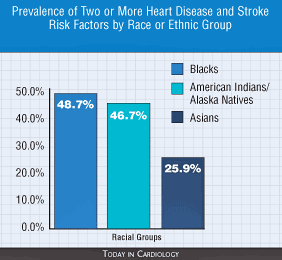CHD risk disparities severe among some racial, demographic groups
Report from the Centers for Disease Control and Prevention was the first to compare CHD risk factor data state by state.
Disparities in risk factors for heart disease and stroke are “quite substantial” across racial, socioeconomic and demographic lines, according to a report from the Centers for Disease Control and Prevention.
The report, published in a recent Journal of the American Medical Association, covers the year 2003 and is the first such survey to conduct state-by-state comparisons, Donald Hayes, MD, MPH, a research fellow at the Centers for Disease Control and Prevention, said.
Six risk factors
Researchers focused on the following six modifiable risk factors: high blood pressure, high cholesterol, diabetes, tobacco use, obesity and lack of exercise.
“We are the first who were able to observe these six risk factors on a national as well as a state-by-state level,” Hayes told Cardiology Today. “This information is something that clinicians can use to identify those groups of people who are most likely to display these risk factors.”
 The prevalence of two or more of these risk factors varied by
state or territory. Hawaii had the lowest rate of two or more risk factors at
27%, while Kentucky had the highest at 46.2%.
The prevalence of two or more of these risk factors varied by
state or territory. Hawaii had the lowest rate of two or more risk factors at
27%, while Kentucky had the highest at 46.2%.
The following 12 states and territories had a multiple risk factor prevalence of >40%: Alabama, Arkansas, Georgia, Indiana, Kentucky, Louisiana, Mississippi, North Carolina, Ohio, Oklahoma, Tennessee, West Virginia, Guam and Puerto Rico.
The percentage of participants who reported having two or more risk factors was highest among blacks (48.7%) and American Indians/Alaskan Natives (46.7%), and lowest among Asians (25.9%).
“One of the categories of racial and ethnic groups is multiple races, and that includes people from multi-racial families. However, our numbers are much too small to do statistical analysis on the national level, and it’s an area that should be pursued,” Hayes said.
No difference in risk factor prevalence was noted between men and women; about 37% had two or more risk factors in both groups.
Education and income
Education was associated with the presence of multiple risk factors with the lowest rate seen among college graduates (25.9%) and the highest seen among those who did not complete high school (52.5%).
Employment status also was associated with risk factors. Adults who said they were unable to work had the highest prevalence of two or more risk factors (69.3%), followed by retired persons (45.1%), unemployed adults (43.5%), homemakers (34.3%) and employed adults (34%).
Presence of two or more risk factors was also associated with income: households reporting >$50,000 had the lowest prevalence (28.8%) and those reporting <$10,000 had the highest prevalence (52.5%).
“This could be a proxy measurement for employment status or other socioeconomic risk factors, but our study was not designed to look at that,” Hayes said.
BRFSS survey
CDC analyzed data from the 2003 Behavioral Risk Factor Surveillance System survey, which included 256,155 participants from 50 states, the District of Columbia, Puerto Rico, Guam and the U.S. Virgin Islands.
Overall, 25.6% of participants reported having high blood pressure, 25.3% reported having high cholesterol, 25% were obese, 24.1% were physically inactive, 22.6% were current smokers, and 7.4% had diabetes.
No risk factors were seen in 29.8% of participants, 33.1% reported having one risk factor and 37.2% of patients reported having two or more risk factors. – by Jeremy Moore
For more information:
- Hayes DK, Greenlund KJ, Denny CH, et al. Racial/ethnic and socioeconomic disparities in multiple risk factors for heart disease and stroke—United States, 2003. JAMA. 2005;293:1441-1442.
